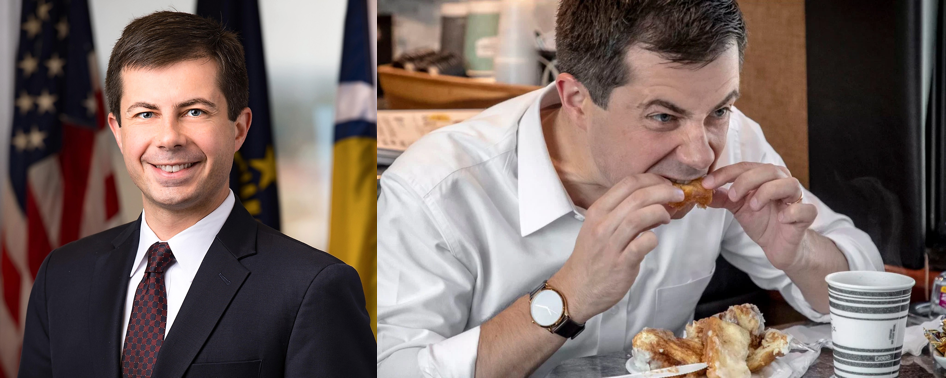It’s official: Presidential candidate Pete Buttigieg is straight-up incapable of eating a cinnamon roll. In the latest of his food fiascos, the South Bend mayor readily bastardized the sacred American art of eating chicken wings, having so elegantly applied the technique to his breakfast buns.
Buttigieg is not the first to cause such a ruckus with his diet documentation; Franklin D. Roosevelt, Richard Nixon and Jimmy Carter are amongst those touting iconic photos of themselves eating everyday foods. More recently, 2003 presidential candidate John Kerry’s infamous “swiss cheesesteak” gaffe was (jokingly) thought to have cost him Pennsylvania.
Thus, the ensuing tide of Twitter comments and criticisms from other candidates in response to Buttigieg’s finger food foolery, while a welcome addition to the already-hilarious situation, also underscore some larger questions: Why do such seemingly trivial stories like these tend to make headlines, and why do Americans care so much about what and how our politicians eat?
According to Eater, political eating is “one of the few ways a politician can allow actions to speak louder than words.” A fundamental reciprocity is evoked in seeing, for instance, Bernie Sanders munching on a corn dog — the public tends to empathize with political candidates who live like the average American.
It’s no secret that the political world is deeply entangled with inauthentic, “shady stuff” like lobbying and foreign interest groups, so of course Americans want to see what our political candidates are really like behind the scenes. We rely on the act of eating — a brief respite from the complications of maintaining public appearance — to offer this treasured insight into the “authenticity” of a candidate. It’s both a way for us to discover new sides to our representatives and perhaps confirm any existing biases.
Unfortunately, it often backfires on us (hence the air quotes on “authenticity”). Such is the case with Buttigieg, who welcomed a 36-hour video documentation of his mealtimes all in pursuit of increasing his own perceived relatability. In this way, the act of eating loses its authenticity, instead becoming a tool of political agenda; does Buttigieg really suck at eating cinnamon rolls, or was it all for the publicity?
Just for fun, let’s take this a step further. While this comparison may come as a slight stretch, I believe the fascinating psychological phenomenon known as the “uncanny valley” is relevant here. The “uncanny valley” refers to the idea that entities that only slightly stray from complete humanity are far more terrifying than obvious fictions. In other words, it’s what makes the Google android cute while more “human-like” personas, such as internet sensation Poppy, are so unsettling.
Now consider the daily life of a politician: an incessant montage of smiling, waving and assuring the public that everything is under control and functioning properly. Executed with a robotic sense of precision, these rigid responsibilities all contribute to the image of an emotionless, poised politician. Were they truly robots or androids with human flesh, as per the “uncanny valley” theory, they would make the ultimate, unsettling structural analogs. So what protects them from this effect? I would argue that these quirky “sneak-peeks” into their private lives presented through political eating allow us to definitively distinguish their humanity (just in case it was ever of concern).
If you think I’m over-dramatizing this, you’re probably right, but take a look at the two photos of Pete Buttigieg above. In the photo on the left, we arguably enter “uncanny valley” territory as his deadpan eyes seem at odds with his grinning expression. To put it bluntly, he looks like a CS 106A student’s first attempt at “smile.exe.” The photo on the right, in contrast, shows Buttigieg engrossed in action: just a man and his cinnamon roll wings. There’s a raw, organic energy to his forceful expression that simply isn’t replicable by the latest and greatest in robotic development.
Maybe I’m just another gullible voter, but while Buttigieg looks prim, proper and professional (as he should) in the first photo, I personally feel more comfortable supporting someone who doesn’t seem so inhumanly far-removed, someone who’s always down to chow down on some “wings” like the rest of us.
One final analogy: Just like seeing teachers at the grocery store or anywhere outside of school, there’s an unmistakable awkwardness to these situations (especially for the political candidate, I imagine), but there’s simultaneously a strange sense of connection forged from the perceived intimacy of the moment. Once you’ve seen Mr. Buttigieg shopping in the chicken wings aisle, that’s all you’ll think of whenever you see him next.
This is perhaps what encourages journalists to seek out and cover these encounters, what inspires millions of online comments and opinions from frenzied social media users, what provides protection against the inhuman, inauthentic veneer of politics. The power and true purpose of political eating — breaking down barriers between politicians and citizens — is not only something we Americans fall for all the time, but it also establishes a type of connection we hunger for. In fact, you could say we’re ravenous.
Contact Carissa Lee at carislee ‘at’ stanford.edu.
